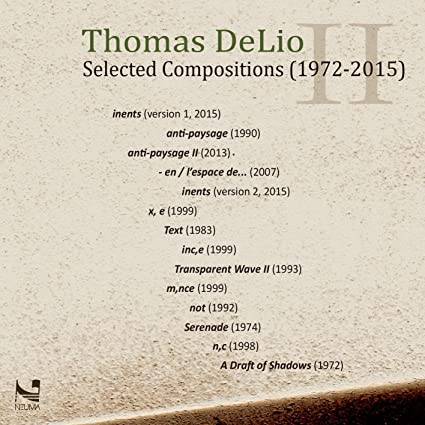Thomas Delio (b. 1951) è un compositore che lavora con un senso espansivo dei suoni e degli spazi interni ad essi. Una raccolta di opere selezionate, pubblicate dall’etichetta discografica Neuma, fornisce un compendio efficace del suo lavoro nel periodo 1991-2013. La raccolta comprende opere strumentali, produzione di testi, e pezzi meramente elettronici. Anche se i pezzi differiscono l’uno dall’altro in termini di formato, materiali e orchestrazione, tutti condividono quella che potremmo chiamare una estetica di intermittenza, cioè, un focus sul suono che si materializza in ben definite isole di tempo.
________________________________________________________________________
The turn away from pitch and toward sound as such as the fundamental element of musical composition and performance is one of the hallmarks of a significant strain of late twentieth century art music. This reevaluation of the relative weights of compositional elements continues to exert an influence on composers and performers, many of whom take for granted the status of pitch as one point along a larger compass of sounds. Thomas DeLio is one such composer for whom this expansive sense of musical sound, and the consequently catholic sonic palette to which it gives rise, opened a field in which his own practice could flourish.
DeLio (b. 1951) studied under Robert Cogan at the New England Conservatory of Music, after which he pursued interdisciplinary studies in music, mathematics and visual art. He is a music theorist as well as a composer, having written or contributed to many academic books and journals since the late 1970s. His compositions, which were inspired by the sonic and formal vocabularies of such forerunners as Iannis Xenakis, John Cage and others, draw on the full range of sound sources available to contemporary composers–pitched and unpitched acoustic instruments, voice, and electronics—as well as on the organizational possibilities opened up by disjunctive forms. This can be heard in the compilation of selected works recently released on the Neuma label, which provides a substantial survey of his work over the period 1991-2013. The collection includes instrumental works, mostly for soloists or small groups, settings of texts, and purely electronic pieces. Although the pieces differ from one another in terms of format, materials and orchestration, all of them share what might be called an aesthetic of intermittence—that is, a focus on sound as such standing alone in well-defined islands of time.
The electronic compositions z, rb (2000) and ,c el, f (2001) exemplify DeLio’s work in that medium. In both pieces, each of which is of less than two minutes’ duration, brief bursts of electronic sounds, some lasting no more than one second, are separated by much longer expanses of sonically empty space. Than (1991), the only work for orchestra represented here, similarly intersperses sound blocks and pitch collections with long silences over its approximately four minute length. The same structural sense informs the pairings of what DeLio calls “deconstructions”—works that involve the electronic manipulation of a recording of a performance of a prior composition—with the original works that provided their source material. As though (1991) for solo percussion, realized by Jeffrey Gram, is an episodic survey of the drum kit; the “deconstruction” as though/of (1999) modifies the shapes and timbres of Gram’s performance while retaining its distinctive profile.
DeLio’s interest in fragmentary sounds comes into play in a conceptually intriguing way in his settings of texts, particularly in his settings of poetry by P. Inman, here represented by Song: “aengus” (2013). Inman, a writer associated with the East Coast branch of “language” poetry, breaks language into shards of isolated words or non-signifying combinations of letters. This is analogous to DeLio’s separation of sounds into objects conveying only their formal properties of timbre, duration, dynamics and occasionally pitch. To read Inman’s poetry is to read linguistic elements that refuse to represent reality but rather insist on embodying a concrete reality in themselves; similarly, DeLio’s sounds appear not to want to function as parts of larger musical motifs but instead to be motifs in and of themselves, or at least the functional equivalent of motifs.
In all of these works, and in DeLio’s work more generally, silence acts as a boundary or frame. Long passages devoid of musical or sonic activity act as interstices by virtue of which sounds are set off from one another to be heard as independent entities. Their discontinuity vests them with a certain fleetingness or intermittence. But in defining boundaries between sounds and casting them as events, these interstices also set up relationships between and among those events. The empty passage—the negative space—both links the succeeding event to a preceding event and creates the larger context in which events transpire. Negative spaces thus engender a set of structural relationships—separations, adjacencies, priority and succession and so forth. And these relationships make possible the qualitative relationships that allow us to hear similarities and differences based on such sonic parameters as timbre, pitch, duration, dynamics and phrasing.
In the end an aesthetic of intermittence is an aesthetic of relationships, and one in which the attentive perception of the qualities of individual sound objects can be cultivated and indeed relished. DeLio’s work affords many opportunities for doing just such a thing.







